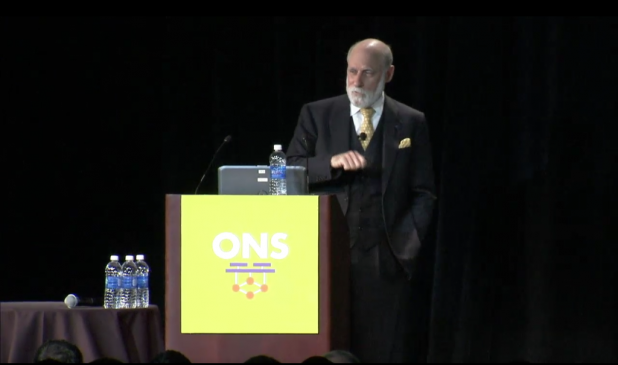 Vint Cerf.[/caption] Vint Cerf, one of the "founders of the Internet," told an audience April 16 that if he could do it all over again, he would construct the Internet in the mold of Software-Defined Networking (SDN). Cerf, who co-designed the TCP/IP protocol suite with Bob Kahn, said that he admired how SDN separates the data plane from the control plane, which allows the network to be controlled via software from an external server. One of the hazards of conjoining the two, he added, was the attack risk. "I wish we had done [the separation] in the Internet design, but we didn't," Cerf told the audience for his keynote address at the Open Networking Summit in Santa Clara, Calif. Cerf is now an employee of Google, serving as vice president and chief Internet evangelist. "In a very interesting way you have an opportunity to reinvent this whole notion of networking," he added. Cerf’s appearance onstage mimicked the James Bond skydive stunt that opened the Olympics, with a Bond double even lauding him as a "hero.” But Cerf’s speech more resembled that of an elder statesman counseling caution, from one who had been down the same road before. As such, Cerf argued that the development of software-defined networking technologies was an opportunity for innovation, which is already starting to flourish. But he also argued that specifications, and the interoperability they enabled, would be necessary for the technology to become prevalent. "If you are off in the software-defined networking space, this is an undefined space," he said. "Just because it says software-defined networking doesn't mean they're the same thing. That's like 'cloud...They're not the same thing, and similarly you can invest in an arbitrarily large number of software-defined networks.” If people want things to interoperate, he added, then standards are increasingly important: "This isn't to say you shouldn't explore brand new ideas, or things that might be incompatible, but as you get to the point where you want to have something big happen, spend some time working on getting agreement on standards.” That creates an opportunity for competition, “because multiple parties can build things to that standard—that's certainly what happened in the creation of the Internet—and these standards often create a certain amount of stability. And stability is your friend in networking environments. If you can't rely on some stable point in the architecture, you'll have some trouble in making things work reliably." Finally, he said, SDNs (and all networks) should be designed to be adaptable for change. Oddly, Cerf also gave a shout-out to marketing departments, arguing that businesses should not seek to control overarching standards but instead focus on their implementations—branding them in such a way as to differentiate one from another: "So you brand the implementation and you brand the service, but please don't patent the protocols.” Google has said previously that it implemented OpenFlow, the open-source network OS that is seen as a facilitator of SDN, beginning in 2010 (a Google-authored PDF whitepaper describing the implementation is available online.) Network utilization climbed to 95 percent, unheard of in the industry. The next step, Cerf said, was to make software programmability a feature of "casual" or merged networks, combining cellular, wireless LAN, satellite, "white spaces," and other networks to push bytes back and forth. Such network intelligence will be necessary as we move farther off-planet, where humans will have to deal with the (relatively slow) speed of light and other problems, such as planets that rotate, blocking signals to routers on Mars. In that case, he said, "store and forward" technologies will need to be developed, with routers caching data and then transmitting it when a connection can be established.
Vint Cerf.[/caption] Vint Cerf, one of the "founders of the Internet," told an audience April 16 that if he could do it all over again, he would construct the Internet in the mold of Software-Defined Networking (SDN). Cerf, who co-designed the TCP/IP protocol suite with Bob Kahn, said that he admired how SDN separates the data plane from the control plane, which allows the network to be controlled via software from an external server. One of the hazards of conjoining the two, he added, was the attack risk. "I wish we had done [the separation] in the Internet design, but we didn't," Cerf told the audience for his keynote address at the Open Networking Summit in Santa Clara, Calif. Cerf is now an employee of Google, serving as vice president and chief Internet evangelist. "In a very interesting way you have an opportunity to reinvent this whole notion of networking," he added. Cerf’s appearance onstage mimicked the James Bond skydive stunt that opened the Olympics, with a Bond double even lauding him as a "hero.” But Cerf’s speech more resembled that of an elder statesman counseling caution, from one who had been down the same road before. As such, Cerf argued that the development of software-defined networking technologies was an opportunity for innovation, which is already starting to flourish. But he also argued that specifications, and the interoperability they enabled, would be necessary for the technology to become prevalent. "If you are off in the software-defined networking space, this is an undefined space," he said. "Just because it says software-defined networking doesn't mean they're the same thing. That's like 'cloud...They're not the same thing, and similarly you can invest in an arbitrarily large number of software-defined networks.” If people want things to interoperate, he added, then standards are increasingly important: "This isn't to say you shouldn't explore brand new ideas, or things that might be incompatible, but as you get to the point where you want to have something big happen, spend some time working on getting agreement on standards.” That creates an opportunity for competition, “because multiple parties can build things to that standard—that's certainly what happened in the creation of the Internet—and these standards often create a certain amount of stability. And stability is your friend in networking environments. If you can't rely on some stable point in the architecture, you'll have some trouble in making things work reliably." Finally, he said, SDNs (and all networks) should be designed to be adaptable for change. Oddly, Cerf also gave a shout-out to marketing departments, arguing that businesses should not seek to control overarching standards but instead focus on their implementations—branding them in such a way as to differentiate one from another: "So you brand the implementation and you brand the service, but please don't patent the protocols.” Google has said previously that it implemented OpenFlow, the open-source network OS that is seen as a facilitator of SDN, beginning in 2010 (a Google-authored PDF whitepaper describing the implementation is available online.) Network utilization climbed to 95 percent, unheard of in the industry. The next step, Cerf said, was to make software programmability a feature of "casual" or merged networks, combining cellular, wireless LAN, satellite, "white spaces," and other networks to push bytes back and forth. Such network intelligence will be necessary as we move farther off-planet, where humans will have to deal with the (relatively slow) speed of light and other problems, such as planets that rotate, blocking signals to routers on Mars. In that case, he said, "store and forward" technologies will need to be developed, with routers caching data and then transmitting it when a connection can be established. Vint Cerf: SDN Is a Model for a Better Internet
[caption id="attachment_9200" align="aligncenter" width="618"]  Vint Cerf.[/caption] Vint Cerf, one of the "founders of the Internet," told an audience April 16 that if he could do it all over again, he would construct the Internet in the mold of Software-Defined Networking (SDN). Cerf, who co-designed the TCP/IP protocol suite with Bob Kahn, said that he admired how SDN separates the data plane from the control plane, which allows the network to be controlled via software from an external server. One of the hazards of conjoining the two, he added, was the attack risk. "I wish we had done [the separation] in the Internet design, but we didn't," Cerf told the audience for his keynote address at the Open Networking Summit in Santa Clara, Calif. Cerf is now an employee of Google, serving as vice president and chief Internet evangelist. "In a very interesting way you have an opportunity to reinvent this whole notion of networking," he added. Cerf’s appearance onstage mimicked the James Bond skydive stunt that opened the Olympics, with a Bond double even lauding him as a "hero.” But Cerf’s speech more resembled that of an elder statesman counseling caution, from one who had been down the same road before. As such, Cerf argued that the development of software-defined networking technologies was an opportunity for innovation, which is already starting to flourish. But he also argued that specifications, and the interoperability they enabled, would be necessary for the technology to become prevalent. "If you are off in the software-defined networking space, this is an undefined space," he said. "Just because it says software-defined networking doesn't mean they're the same thing. That's like 'cloud...They're not the same thing, and similarly you can invest in an arbitrarily large number of software-defined networks.” If people want things to interoperate, he added, then standards are increasingly important: "This isn't to say you shouldn't explore brand new ideas, or things that might be incompatible, but as you get to the point where you want to have something big happen, spend some time working on getting agreement on standards.” That creates an opportunity for competition, “because multiple parties can build things to that standard—that's certainly what happened in the creation of the Internet—and these standards often create a certain amount of stability. And stability is your friend in networking environments. If you can't rely on some stable point in the architecture, you'll have some trouble in making things work reliably." Finally, he said, SDNs (and all networks) should be designed to be adaptable for change. Oddly, Cerf also gave a shout-out to marketing departments, arguing that businesses should not seek to control overarching standards but instead focus on their implementations—branding them in such a way as to differentiate one from another: "So you brand the implementation and you brand the service, but please don't patent the protocols.” Google has said previously that it implemented OpenFlow, the open-source network OS that is seen as a facilitator of SDN, beginning in 2010 (a Google-authored PDF whitepaper describing the implementation is available online.) Network utilization climbed to 95 percent, unheard of in the industry. The next step, Cerf said, was to make software programmability a feature of "casual" or merged networks, combining cellular, wireless LAN, satellite, "white spaces," and other networks to push bytes back and forth. Such network intelligence will be necessary as we move farther off-planet, where humans will have to deal with the (relatively slow) speed of light and other problems, such as planets that rotate, blocking signals to routers on Mars. In that case, he said, "store and forward" technologies will need to be developed, with routers caching data and then transmitting it when a connection can be established.
Vint Cerf.[/caption] Vint Cerf, one of the "founders of the Internet," told an audience April 16 that if he could do it all over again, he would construct the Internet in the mold of Software-Defined Networking (SDN). Cerf, who co-designed the TCP/IP protocol suite with Bob Kahn, said that he admired how SDN separates the data plane from the control plane, which allows the network to be controlled via software from an external server. One of the hazards of conjoining the two, he added, was the attack risk. "I wish we had done [the separation] in the Internet design, but we didn't," Cerf told the audience for his keynote address at the Open Networking Summit in Santa Clara, Calif. Cerf is now an employee of Google, serving as vice president and chief Internet evangelist. "In a very interesting way you have an opportunity to reinvent this whole notion of networking," he added. Cerf’s appearance onstage mimicked the James Bond skydive stunt that opened the Olympics, with a Bond double even lauding him as a "hero.” But Cerf’s speech more resembled that of an elder statesman counseling caution, from one who had been down the same road before. As such, Cerf argued that the development of software-defined networking technologies was an opportunity for innovation, which is already starting to flourish. But he also argued that specifications, and the interoperability they enabled, would be necessary for the technology to become prevalent. "If you are off in the software-defined networking space, this is an undefined space," he said. "Just because it says software-defined networking doesn't mean they're the same thing. That's like 'cloud...They're not the same thing, and similarly you can invest in an arbitrarily large number of software-defined networks.” If people want things to interoperate, he added, then standards are increasingly important: "This isn't to say you shouldn't explore brand new ideas, or things that might be incompatible, but as you get to the point where you want to have something big happen, spend some time working on getting agreement on standards.” That creates an opportunity for competition, “because multiple parties can build things to that standard—that's certainly what happened in the creation of the Internet—and these standards often create a certain amount of stability. And stability is your friend in networking environments. If you can't rely on some stable point in the architecture, you'll have some trouble in making things work reliably." Finally, he said, SDNs (and all networks) should be designed to be adaptable for change. Oddly, Cerf also gave a shout-out to marketing departments, arguing that businesses should not seek to control overarching standards but instead focus on their implementations—branding them in such a way as to differentiate one from another: "So you brand the implementation and you brand the service, but please don't patent the protocols.” Google has said previously that it implemented OpenFlow, the open-source network OS that is seen as a facilitator of SDN, beginning in 2010 (a Google-authored PDF whitepaper describing the implementation is available online.) Network utilization climbed to 95 percent, unheard of in the industry. The next step, Cerf said, was to make software programmability a feature of "casual" or merged networks, combining cellular, wireless LAN, satellite, "white spaces," and other networks to push bytes back and forth. Such network intelligence will be necessary as we move farther off-planet, where humans will have to deal with the (relatively slow) speed of light and other problems, such as planets that rotate, blocking signals to routers on Mars. In that case, he said, "store and forward" technologies will need to be developed, with routers caching data and then transmitting it when a connection can be established.
 Vint Cerf.[/caption] Vint Cerf, one of the "founders of the Internet," told an audience April 16 that if he could do it all over again, he would construct the Internet in the mold of Software-Defined Networking (SDN). Cerf, who co-designed the TCP/IP protocol suite with Bob Kahn, said that he admired how SDN separates the data plane from the control plane, which allows the network to be controlled via software from an external server. One of the hazards of conjoining the two, he added, was the attack risk. "I wish we had done [the separation] in the Internet design, but we didn't," Cerf told the audience for his keynote address at the Open Networking Summit in Santa Clara, Calif. Cerf is now an employee of Google, serving as vice president and chief Internet evangelist. "In a very interesting way you have an opportunity to reinvent this whole notion of networking," he added. Cerf’s appearance onstage mimicked the James Bond skydive stunt that opened the Olympics, with a Bond double even lauding him as a "hero.” But Cerf’s speech more resembled that of an elder statesman counseling caution, from one who had been down the same road before. As such, Cerf argued that the development of software-defined networking technologies was an opportunity for innovation, which is already starting to flourish. But he also argued that specifications, and the interoperability they enabled, would be necessary for the technology to become prevalent. "If you are off in the software-defined networking space, this is an undefined space," he said. "Just because it says software-defined networking doesn't mean they're the same thing. That's like 'cloud...They're not the same thing, and similarly you can invest in an arbitrarily large number of software-defined networks.” If people want things to interoperate, he added, then standards are increasingly important: "This isn't to say you shouldn't explore brand new ideas, or things that might be incompatible, but as you get to the point where you want to have something big happen, spend some time working on getting agreement on standards.” That creates an opportunity for competition, “because multiple parties can build things to that standard—that's certainly what happened in the creation of the Internet—and these standards often create a certain amount of stability. And stability is your friend in networking environments. If you can't rely on some stable point in the architecture, you'll have some trouble in making things work reliably." Finally, he said, SDNs (and all networks) should be designed to be adaptable for change. Oddly, Cerf also gave a shout-out to marketing departments, arguing that businesses should not seek to control overarching standards but instead focus on their implementations—branding them in such a way as to differentiate one from another: "So you brand the implementation and you brand the service, but please don't patent the protocols.” Google has said previously that it implemented OpenFlow, the open-source network OS that is seen as a facilitator of SDN, beginning in 2010 (a Google-authored PDF whitepaper describing the implementation is available online.) Network utilization climbed to 95 percent, unheard of in the industry. The next step, Cerf said, was to make software programmability a feature of "casual" or merged networks, combining cellular, wireless LAN, satellite, "white spaces," and other networks to push bytes back and forth. Such network intelligence will be necessary as we move farther off-planet, where humans will have to deal with the (relatively slow) speed of light and other problems, such as planets that rotate, blocking signals to routers on Mars. In that case, he said, "store and forward" technologies will need to be developed, with routers caching data and then transmitting it when a connection can be established.
Vint Cerf.[/caption] Vint Cerf, one of the "founders of the Internet," told an audience April 16 that if he could do it all over again, he would construct the Internet in the mold of Software-Defined Networking (SDN). Cerf, who co-designed the TCP/IP protocol suite with Bob Kahn, said that he admired how SDN separates the data plane from the control plane, which allows the network to be controlled via software from an external server. One of the hazards of conjoining the two, he added, was the attack risk. "I wish we had done [the separation] in the Internet design, but we didn't," Cerf told the audience for his keynote address at the Open Networking Summit in Santa Clara, Calif. Cerf is now an employee of Google, serving as vice president and chief Internet evangelist. "In a very interesting way you have an opportunity to reinvent this whole notion of networking," he added. Cerf’s appearance onstage mimicked the James Bond skydive stunt that opened the Olympics, with a Bond double even lauding him as a "hero.” But Cerf’s speech more resembled that of an elder statesman counseling caution, from one who had been down the same road before. As such, Cerf argued that the development of software-defined networking technologies was an opportunity for innovation, which is already starting to flourish. But he also argued that specifications, and the interoperability they enabled, would be necessary for the technology to become prevalent. "If you are off in the software-defined networking space, this is an undefined space," he said. "Just because it says software-defined networking doesn't mean they're the same thing. That's like 'cloud...They're not the same thing, and similarly you can invest in an arbitrarily large number of software-defined networks.” If people want things to interoperate, he added, then standards are increasingly important: "This isn't to say you shouldn't explore brand new ideas, or things that might be incompatible, but as you get to the point where you want to have something big happen, spend some time working on getting agreement on standards.” That creates an opportunity for competition, “because multiple parties can build things to that standard—that's certainly what happened in the creation of the Internet—and these standards often create a certain amount of stability. And stability is your friend in networking environments. If you can't rely on some stable point in the architecture, you'll have some trouble in making things work reliably." Finally, he said, SDNs (and all networks) should be designed to be adaptable for change. Oddly, Cerf also gave a shout-out to marketing departments, arguing that businesses should not seek to control overarching standards but instead focus on their implementations—branding them in such a way as to differentiate one from another: "So you brand the implementation and you brand the service, but please don't patent the protocols.” Google has said previously that it implemented OpenFlow, the open-source network OS that is seen as a facilitator of SDN, beginning in 2010 (a Google-authored PDF whitepaper describing the implementation is available online.) Network utilization climbed to 95 percent, unheard of in the industry. The next step, Cerf said, was to make software programmability a feature of "casual" or merged networks, combining cellular, wireless LAN, satellite, "white spaces," and other networks to push bytes back and forth. Such network intelligence will be necessary as we move farther off-planet, where humans will have to deal with the (relatively slow) speed of light and other problems, such as planets that rotate, blocking signals to routers on Mars. In that case, he said, "store and forward" technologies will need to be developed, with routers caching data and then transmitting it when a connection can be established. 

